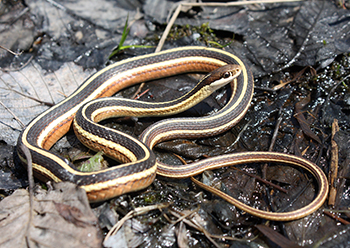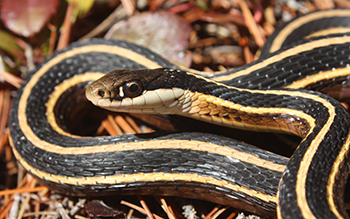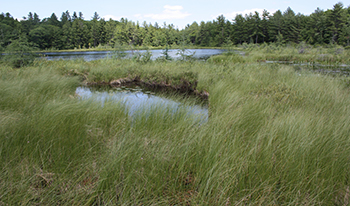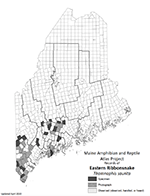Home → Fish & Wildlife → Wildlife → Species Information → Reptiles & Amphibians → Eastern Ribbonsnake
Eastern Ribbonsnake
Sample
On this page:

Photo: Trevor Persons
Distinguishing Characteristics

Photo: Trevor Persons
- Medium-sized, approximately 16 to 35 inches in length
- Three light yellow stripes contrast against a dark background
- Slender body, with long thin tail comprising ~1/3 of total body length
- Small spot of light yellow or off-white in front of each eye
- Dorsal scales keeled (longitudinal raised ridge along midline of each scale)
- Commonly confused with common gartersnake
Status and Distribution in Maine
- State Special Concern; Species of Greatest Conservation Need
- Uncommon
- Southern and central regions
Habitat

Photo: Trevor Persons
- Shallow and semi-permanent wetlands with abundant emergent and shrubby vegetation, including large vernal pools, shrub swamps, wet meadows, bogs, and small marshy ponds
Diet
- Eats mostly frogs and salamanders, but also fish, leeches, and other invertebrates
Seasonal Changes
- Overwinters in upland settings, in ant mounds, rodent burrows, and root tunnels
Natural History Notes
- Highly aquatic; only common watersnake is more often found near water
- Gives birth to live young in July and August
Share Your Sighting
There is much still to learn about the distribution and ecology of Maine’s herpetofauna, and we encourage members of the public to share their photo-documented observations as part of the Maine Amphibian & Reptile Atlas Project (MARAP).
To see if a township still needs documentation of a species, consult this distribution map (PDF). If a township lacks a photo or specimen record, we want your observation!
There are two ways to share your observations:
Submit your reptile or amphibian observation online
No service? No problem. Click here to download the survey to your device while connected, then take offline to collect observations from anywhere. Tip: The survey works best on Google Chrome and Safari.
Or upload sightings to the iNaturalist citizen science project through their website at iNaturalist.org or mobile app.
- When submitting an observation through iNaturalist add a description of the location (and other noteworthy information) to the “notes” field. This serves as a check on the locations automatically generated by smartphone cameras, which may be imprecise if cell service or GPS coverage is weak.
Thank you for doing your part to help conserve Maine’s reptiles and amphibians.
